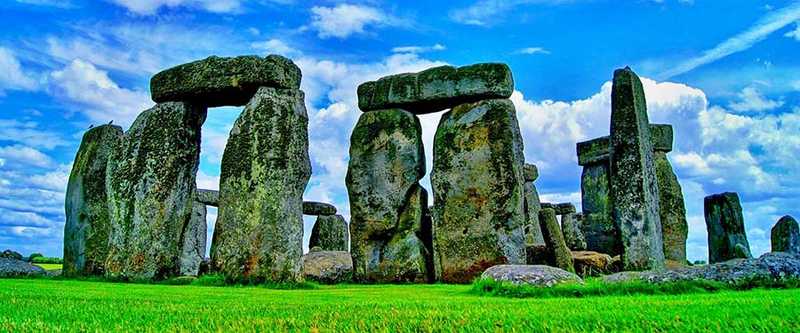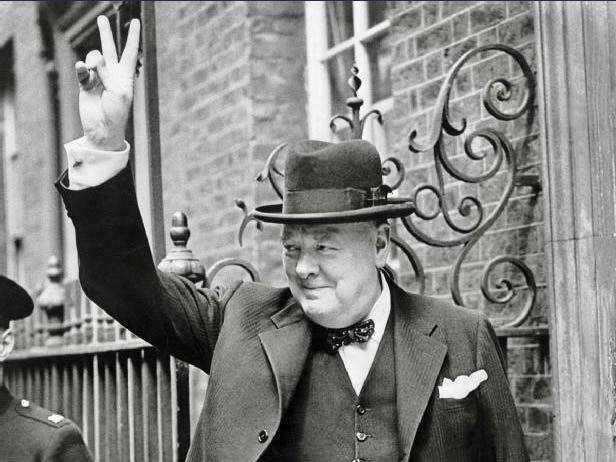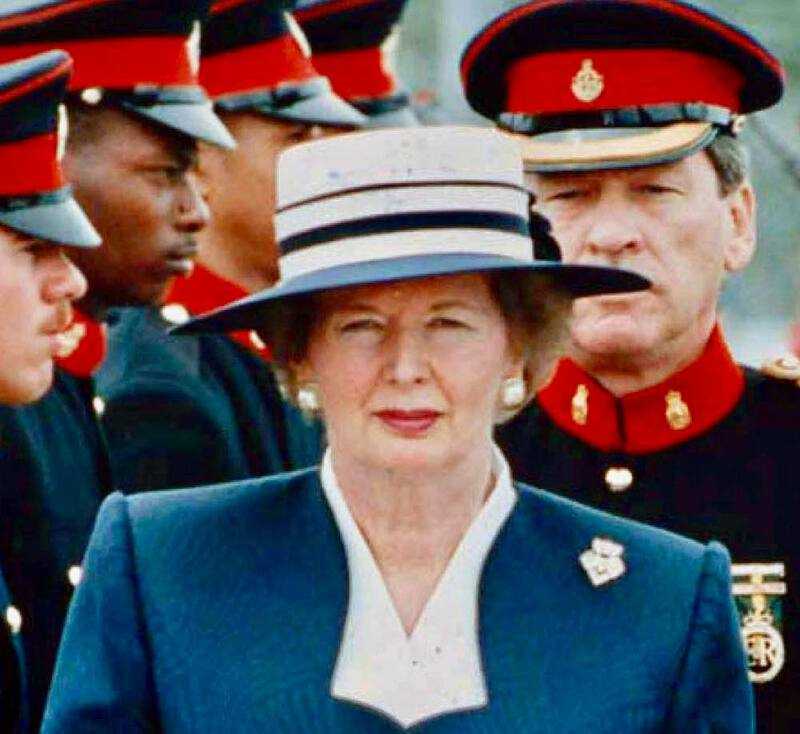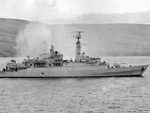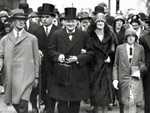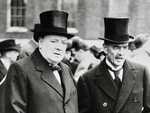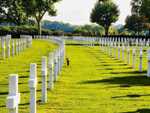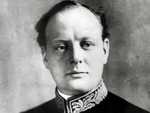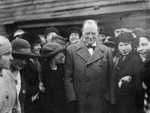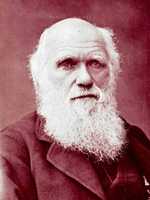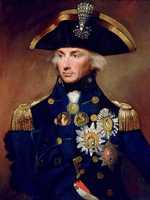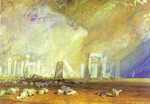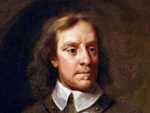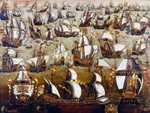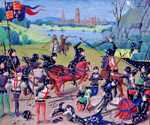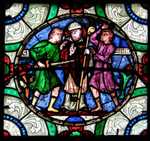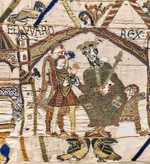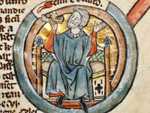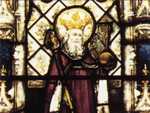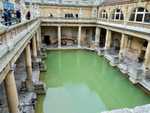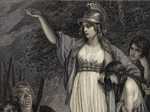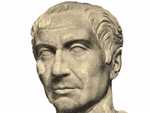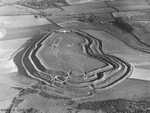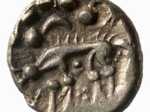1. Post-War Britain
Britain has had to redefine herself after the Second World War.
No longer a political or economic superpower, Britain has instead excelled in the arts, the development of cutting-edge technology, the service industries, and in sport.
8 September 2022: Queen Elizabeth II dies aged 96, after 70 years on the throne. Her reign is characterised by her calm, grace and selfless service to the British people. Elizabeth is succeeded by King Charles III. One of her last acts was to swear in Liz Truss as Prime Minister, following a conservative leadership election after Boris Johnson was ousted following a string of scandals that called his probity into serious question.
23 March 2020: Boris Johnson announces that the country will enter lockdown to combat the Coronavirus pandemic sweeping the globe. The measures, which continued in full force until 4 July, prevented people from leaving their homes other than for essential journeys and a single daily exercise session. They are the most significant peacetime restrictions on daily life ever imposed.
31 January 2020: After years of fraught political wrangling, Britain leaves the EU under the premiership of Boris Johnson. Johnson took control of the conservative party after an exit deal negotiated by former PM Theresa May failed to gain the assent of parliament. Johnson's conservative party trounced Jeremy Corbyn's labour party in the ensuing December 2019 general election.
23 June 2016: After a bitterly fought referendum, Britain votes by a small majority (51.9% to 48.1%) to leave the European Union.
2012: London hosts the Summer Olympic Games. Great Britain secures 65 medals (29 of them gold), ranking third in the medal table (behind the US and China and ahead of Russia and other European nations).
2005: England regains the Ashes, beating Australia in a thrilling summer of cricket that grips the nation.
2003: England wins the Rugby World Cup, beating the hosts Australia 20-17 after extra time in a topsy-turvy game in Sydney. Jonny Wilkinson's drop-goal seals victory in the final minute.
Key Event 1: The Internet
1991: The internet is invented by Tim Berners-Lee. The invention is the most important in the field of communications since the Gutenberg printing press. It is now used by over 4.177 billion people. Tim BL, as he is known online, has spent the next 28 years refining his idea and acting as a guardian of the web.
1981: England win the Ashes, rejuvenated by a swashbuckling 149 not out by Ian Botham at Headingley.
1979-90: Margaret Thatcher is prime minister. Her right-wing policies of privatisation and breaking the trade unions prove controversial but pave the way for the economic booms of the 1990s and early 2000s. Between April and June 1982, Britain successfully recaptures the Falkland Islands after they are invaded by Argentina. Thatcher was known for her big perm, handbags, strong leadership and oratory:
"The Lady's not for turning."
"In politics, if you want anything said, ask a man. If you want anything done, ask a woman."
"Don't follow the crowd, let the crowd follow you."
"The problem with socialism is that you eventually run out of other people's money."
1973: Britain is crippled by strikes, leading to the introduction of the three-day working week between January and March 1974 (designed to preserve electricity when coal miners were on strike).
1973: Britain joins the EEC, its membership having been blocked for a number of years by Charles de Gaulle. A referendum followed two years later, when voters emphatically ratified Britain's membership (67.2% for and 32.8% against)
30 July 1966: England wins the Football World Cup, beating West Germany 4-2 in the final held at Wembley, West London. The match was tied at 2-2 after full time, with Geoff Hurst's two extra time goals sealing victory. Captain Bobby Moore was presented with the trophy by Queen Elizabeth II, with the team including legendery defender Bobby Charlton.
1960: The Beatles are formed in Liverpool. Over the next decade the Fab Four become the most important band in history.
Interesting fact ...
The Beatles have sold close to 1 billion albums worldwide, sold 1.7 billion singles in America alone, and had twenty-five number 1 hits in the US. The British statistics are even more impressive. Their hit 'Yesterday' has been covered more than 3,000 times, more than any other song.
June-Dec 1956: President Nasser of Egypt forcibly nationalises the Suez Canal, previously owned and run by the Suez Canal Company (controlled by British and French interests). Britain, France and Israel jointly invade Egypt to retake control and oust Nasser. But their military operation comes to an end under political pressure from the US, USSR and UN. Anthony Eden, the then Prime Minister, resigns in humiliation. The Suez crisis is widely regarded as ending Britain's status as a superpower.
1953: Englishman Francis Crick and American James Watson discover the double-helix structure of DNA whilst working at Cambridge University's Cavendish research laboratory.
2 June 1953: Queen Elizabeth II's coronation (she has actually reigned since 6 February 1952). She is to become the longest-serving monarch, surpassing Queen Victoria's 63 years 216 days on the throne in September 2015. Elizabeth II's coronation comes less than a week after a British-led expedition conquers Mount Everest (though the triumphant climbers, Sir Edmund Hillary and Tenzing Norgay, were from New Zealand and Nepal respectively).
5 July 1948: The National Health Service is founded, under Clement Atlee's labour government. Aneurin Bevan was the health secretary to oversee this healthcare revolution.
15 August 1947: After 89 years of rule, Britain grants independence to India. The last British troops leave through the Gateway of India in Bombay (now Mumbai) on 28 February 1948.
Interesting fact ...
Virtually all of the British empire is dismantled over the next fifty years, though the commonwealth states maintain close bonds. Only 13 "colonies" remain (they are now called British Overseas Territories), all of which have voted to remain governed by Britain, including Gibraltar, Bermuda and the Falkland Islands.
July 1945: Clement Atlee's labour party trounces Churchill's conservatives in an election held immediately after the conclusion of the Second World War. The country decided that the man to lead them in times of war was not a suitable peace-time premier.
2. The Second World War
The Second World War was a close-run thing.
Had the Battle of Britain been lost, Germany would have invaded. As it was, Britain's pilots defended her, America entered the war, the Enigma Code was cracked, the Battle of the Atlantic won, and Europe was re-taken following the audacious D-Day landings.
15 August 1945: Emperor Hirohito announces Japan's unconditional surrender following the dropping of atomic bombs on the cities of Hiroshima on 6 August and Nagasaki three days later.
8 May 1945: Victory in Europe is declared, following Germany's unconditional surrender the previous day.
Key Event 2: D-Day
6 June 1944: D-Day, the amphibious landing of 130,000 allied troops on five Normandy beaches, is launched. The allies face some stiff resistance as they fight their way to Berlin over the next 10 months (stopping at the River Elbe, where they meet the Russians, in April 1945). The allied decision to leave Berlin's capture to the Russians was to have serious repercussions, and the division of the city, during the Cold War.
10 July 1943: This date marked the invasion of Sicily and the start of the Allied invasion of Italy, a campaign that was not to end until 2 May 1945 (just under a week before Germany's unconditional surrender). The campaign was characterised by slow progress, bitter small-scale fighting and huge loss of life.
1941 to 1944: Alan Turing and his team at Bletchley Park crack the Enigma code used by the Germans (and in particular the German navy). Eisenhower was later to say that his work made a "decisive" contribution to the allied victory.
Mid-1943: The allies gain the upper-hand in the Battle of the Atlantic, with the cracking of the Enigma code and advances in radar technology meaning that U-boats were hunted down and destroyed. By this stage, submariners had a c. 75% casualty rate (the highest of all German forces).
11 November: 1942General Bernard Montgomery leads the British and American forces to victory in the Second Battle of El Alamein in north Africa.
7 December 1941: America enters the war following the Japanese attack on the naval base of Pearl Harbour in Hawaii.
June to September 1940: The Battle of Britain is fought over the skies of the southern counties. Britain prevails, but only just, thanks to the heroism of its pilots and the superiority of the Spitfire. As Churchill later said of the RAF pilots:
"Never in the field of human conflict was so much owed by so many to so few."
27 May to 4 June 1940: The British Expeditionary Force, the country's professional army, is evacuated from Dunkirk using a flotilla of small fishing and pleasure boats. Codenamed Operation Dynamo, Churchill was later to describe the Dunkirk evacuation as a "miracle of deliverance". The turnaround was remarkable: only days earlier Churchill reported to the House of Commons that a "colossal military disaster" had taken place.
Churchill updated Parliament immediately after the evacuation. It was a tricky speech: the low countries had been invaded and France was about to fall; but he needed to boost morale. The peroration of the speech he delivered remains world-famous:
We shall fight in France, we shall fight on the seas and oceans, we shall fight with growing confidence and growing strength in the air, we shall defend our island, whatever the cost may be. We shall fight on the beaches, we shall fight on the landing grounds, we shall fight in the fields and in the streets, we shall fight in the hills; we shall never surrender
10 May 1940: Germany invades France, Belgium and Holland using its 'blitzkreig' tactics. On the same day, Churchill replaces Neville Chamberlain as Prime Minister (though a number in the conservative party, and King George VI, favoured the appointment of Lord Halifax).
1 September 1939: Germany invades Poland. Britain and France declare war on Germany two days later, but do little to help Poland. Britain enters a period known as the "phony war", which was to last until April 1940.
3. The Inter-War Years
The interwar years re-shaped British society.
They saw the introduction of near universal suffrage, the nation suffer and recover from the great depression, the abdication of Edward VIII, and finally the misconceived policy of appeasement.
September 1938: Neville Chamberlain returns from a summit in Munich with Adolf Hitler. In return for agreeing to cede parts of Czechoslovakia to the dictator, Chamberlain said that Hitler he had secured Hitler's agreement to "peace in our time". Chamberlain's motives were good, World War I having killed over 8 million, but he was naive.
One of the few to see that Chamberlain was wrong was Winston Churchill. He told Chamberlain:
"You were given the choice between war and dishonour. You chose dishonour, and you will have war."
January 1936: Edward VIII abdicates so that he can marry Wallace Simpson, an American divorcee. In his abdication speech he says:
"But you must believe me when I tell you that I have found it impossible to carry the heavy burden of responsibility and to discharge my duties as King as I would wish to do without the help and support of the woman I love."
1932-3: Douglas Jardine's England beat Australia in the infamous 'Bodline' series. Fast bowlerHarold Larwoodfollows his captain's orders, takes 33 wickets and never plays for England again.
1929-32: The Great Depression, following the New York stock market crash of 1929, hits the nation. Exports halve and unemployment doubles. The country begins to emerge from the downturn in 1934, following the slashing of unemployment benefit to save money and leaving the gold standard (reducing the value of sterling and thus encouraging exports).
1928: Englishman Alexander Fleming isolates penicillin, the antibiotic used today to fight a wide range of bacteria. He was awarded the Nobel Prize for medicine in 1945.
1925: Great Britain re-joins the Gold Standard, linking the value of the pound to the value of gold, a controversial move championed by Winston Churchill.
Key Event 3: End of WWI and Versailles
28 June 1919: The Treaty of Versailles is agreed, principally between Britain, France, the US and Italy (and imposed on Germany). It forces Germany to accept responsibility for the First World War, to make territorial concessions, to pay huge reparations and to disarm. The treaty was criticised at the time by, for example, John Maynard Keynes, for being too harsh. He was proved right: the perception of unfairness in Germany allowed Hitler to seize power in the 1930s.
1918: Following the end of the First World War, the Representation of the People Act 1918 was passed by Parliament. It extended the vote to all men over 21, without any requirement that voters own property. The vote was also extended to women over 30. A decade later women were permitted to vote on the same terms as men.
4. World War One
The First World War, also known as the Great War, led to 1,114,914 British deaths, virtually wiping out a generation of young men.
11 November 1918: An Armistice is signed between the Allies and Germany at Compiègne, France at 5:45 am. It takes effect at 11 am.
9 November 1918: Kaiser Wilhelm abdicates following the success of the Allied Hundred Days Offensive (a series of victories, starting with the Battle of Amiens on 8-10 August 1918, that pushed the Germans back and destroyed their morale). By October 1918 the Germans were sending notes asking for peace to President Wilson and the German navy was mutinying.
21 March 1918: The Germans commence a series of major offensives on the allied line known as Operation Michael. They are repulsed and over the next months the allies counter-attack (buttressed by American forces). Operation Michael had petered out by July 1918
6 April 1917: The US, led by President Woodrow Wilson, enters the war to support Britain and France.
December 1916: Welshman David Lloyd George becomes Prime Minister, replacing H.H.Asquith.
1 July to 18 November 1916: The Battle of the Somme takes place, one of the bloodiest battles in human history. Over three million men take part, with over one million killed or injured. The battle was also the first to feature primitive tanks.
Feb 1915 to Jan 1916: The Gallipoli campaign takes place, the chief sponsor of which is Winston Churchill. The audacious plan is to take control of one of the straits linking the Aegean and Black Seas, thereby weakening the Ottoman empire's supply routes and bolstering Russia. But the amphibious landing was difficult and little progress made. The allied forces give up in January 1916, having sustained casualties of about 302,000.
Christmas Day 1914: British and German soldiers hold football matches in no-man's land, a touching act of humanity in a thoroughly inhumane war. There were some similar gestures the next year, but by 1916 the use of poison gas and the Battle of the Somme brought an end to the tradition.
6-10 September 1914: The Battle of the Marne takes place on the outskirts of Paris. French and British forces, which were in retreat, counter-attack at the Marne River and split the German army in two. The Germans retreat for 65 kilometres and then "dig-in". Trenches soon extend from the channel coast to Switzerland and four years of trench warfare begins.
4 August 1914: Germany invades Belgium, hoping to march through it with little resistance to get around the French fortifications on the France/Germany border. The "Schlieffen" Plan is to overcome France and then focus attention on the Russians (who the Germans thought would take a long time to mobilize). But the Germans meet substantial resistance from Belgian army, supported by the British.
28 June 1914: Archduke Franz Ferdinand is assassinated in Sarajevo, sparking a series of events that lead to the outbreak of World War One: Austria-Hungary (with support from Germany) make a list of unreasonable demands of Serbia and declares war when they are not met; Russia comes to Serbia's aid; and France does likewise, with Britain joining in once Belgium is invaded.
5. Victorian Britain
Victorian Britain saw the rise and rise of Great Britain.
By the time of Queen Victoria's death, Britain was the world's largest economy, had the world's most powerful navy and had an empire on which the sun never set.
22 January 1901: Queen Victoria dies and is succeeded by Edward VII. By this stage, the British empire covered about 20% of the world's land mass.
10 October 1899: The Second Boer War starts in South Africa. The British are criticised for using concentration camps in which tens of thousands of women and children die. The war, supported by Joseph Chamberlain and Lord Kitchner, was no military success either: 250,000 troops and three years were needed to defeat 60,000 farmers. Though two Boer states (Orange Free State and Transvaal) were incorporated into South Africa, this was Great Britain's Vietnam.
1876: Scotsman Alexander Graham Bell invents the telephone.
1 May 1876: Queen Victoria is proclaimed Empress of India, some 18 years after the British Government assumed direct control over India (taking over from the East India Company) when it passed the Government of India Act.
15 August 1867: The Second Reform Act is passed, doubling the size of the electorate and giving about one-third of adult males the vote. Officially known as the Representation of the People Act 1867, the legislation chiefly enfranchised working-class men working in the cities.
1863: The first underground railway is opened in London. Running between Paddington and Farringdon, the railway used steam engines and gas-lit wooden carriages. On its first day it transported 38,000 passengers.
Key Event 4: Darwin's Big Idea
24 November 1859: Charles Darwin's On the Origin of Species is published. The book, accepted as the foundation for evolutionary biology, drew on Darwin's experiences on board The Beagle and proved controversial because it challenged religion and how people saw the world.
1854-6: Britain and France fight Russia in the Crimean War. Notable battles include the Battle of Balaclava, immortalised in Tennyson's Charge of the Light Brigade. Russia sues for peace and the Treaty of Paris brings the war to an end. Meanwhile, Florence Nightingale, also known as the Lady with the Lamp, pioneers modern nursing.
1851: The Great Exhibition is held in Crystal Palace, London. Twenty-five countries take part with over six million visitors attending. The Great Exhibition is the first of a number of world fairs that became popular in the 19th century.
1848: W.G.Grace is born. He is later to become the most famous sportsman of his generation, popularising cricket over the second half of the 19th century.
1845-49: The Irish Famine claims the lives of over a million people and sees about two million emigrate.
1840: The reconstruction of the Houses of Parliament, destroyed by fire in 1837, begins. The gothic structure was not completed for another 30 years, suffering delays, costs overruns and the deaths of its first two architects.
1 August 1838: Slavery is finally abolished in the British Empire when it is outlawed in the Caribbean.
1837-9: Charles Dickens publishes Oliver Twist, his second novel after the Pickwick Papers, about an orphan born into a workhouse and then apprenticed to an undertaker. Characters include Fagin and the Artful Dodger. The book is published by instalments in a magazine called Bentley's Miscellany. It was followed by a string of other hits, including A Tale of Two Cities (which has sold over 200 million copies).
1838: The Great Western Railway, masterminded by Isambard Kingdom Brunel, runs its first trains between Paddington in London and Maidenhead Bridge. The line was later extended to Bristol Temple Meads.
20 June 1837: Queen Victoria ascends to the throne at the age of 18.
6. Georgian Britain
The Georgian period spans 1714 to 1837 and the reigns of Georges I, II, III and IV and William IV.
The period saw the beginnings of the Industrial Revolution, artists such as Gainsborough, Constable and Turner and writers and poets including Austen, Wordsworth, Shelley and Blake.
1837: William IV dies, bringing an end to the Georgian era. He is succeeded by his niece, Queen Victoria.
1833: The Slavery Abolition Act is passed, criminalising slavery.
1832: The Great Reform Act is passed, but it only extends the vote to about one sixth of the population.
1830: George IV dies and is succeeded by his younger brother William IV.
1825: The world's first passenger train runs on the Stockton to Darlington railway in northern England.
1820: George III dies and George, Prince Regent, becomes George IV.
1819: The Peterloo massacre takes place, an unprovoked cavalry charge on peaceful protesters seeking parliamentary reform.
Key Event 5: Waterloo
1815: The Duke of Wellington defeats Napoleon Bonaparte at the Battle of Waterloo, which took place about nine miles from Brussels. But Wellington nearly lost, with last-minute Prussian reinforcements tipping the scales. As Wellington later remarked, it was the "closest-run thing you ever saw in your life". The battle ended centuries of conflict between Britain and France and paved the way for relative peace in Europe until the outbreak of World War One.
1813: Jane Austen's Pride and Prejudice is published.
1811: George III becomes delusional and his powers are taken up by his son, who becomes known as George, Prince Regent.
1807: William Wilberforce's 20-year campaign to outlaw the slave trade culminates in the passing of the Abolition of the Slave Trade Act. But the Act does not make slave owning illegal: that was to take another 27 years.
1805: Admiral Nelson defeats the French and Spanish navies at the Battle of Trafalgar, held off the southwest coast of Spain near Cape Trafalgar. Britain has 27 ships, six fewer than the French and Spanish. Nelson triumphs, sinking or capturing 22 opposing ships, but is fatally wounded during the battle. His body is preserved in a cask of brandy and he is buried in the crypt of St Paul's Cathedral.
1802: John Constable, the finest painter of the English countryside, first exhibits at the Royal Academy.
1800: The Act of Union comes into force, uniting the Kingdoms of Great Britain and Ireland.
1775-1783: Great Britain loses the American Revolutionary wars, being overwhelmed by a combination of American, French, Spanish and Dutch troops. The defeat is regarded as a national disaster, signalling a loss of world influence. But the reversal was more than made up for in the following decades by the expansion of empire.
1775: J.M.W. Turner is born. His paintings of light and dark revolutionise the art world and he goes on to become one of the most famous British artists of all time.
1769-70: Australia and New Zealand are claimed as British colonies by Captain James Cook.
1760: George II dies and is succeeded by his grandson George III, who was known as 'Farmer George' in the early years of his reign on account of his interest in agriculture.
1754-1763: The so-called Seven Years War is held between European nations. Great Britain is victorious, emerging from the war and the 1763 Treaty of Paris with new colonies and the world's most powerful navy.
1727: George I dies and is succeeded by his son George II.
1715: The Whig Party wins the general election held this year and goes on to dominate British politics until 1760.
1714: George I becomes King on the death of Queen Anne. George I, or George Louis Elector of Hanover, is the first of the House of Hanover to rule over the nation. He barely speaks any English and faces an almost immediate rebellion from the Jacobites (who wanted to restore the Stuarts).
7. The Stuarts
The Stuart period spans from 1603 to 1714.
It started with James I. It saw civil war, the execution of Charles I, a brief flirtation with republicanism, and the enactment of the Bill of Rights. And it ended with the death of Queen Anne and accession of the German George I.
1702-07: Queen Anne rules, though her reign is marred by ill-health and her inability to produce an heir (she had 17 pregnancies, which ended in miscarriage, stillbirth or her children dying in infancy). Her death in 1707 marks the end of the Stuart period.
1707: The Act of Union is passed, merging the Kingdoms of England and Scotland. The Union Jack, a merger of the English and Scottish flags, becomes widely used.
1701: The Act of Settlement is passed, regulating succession to the throne. The basic rules are (1) no Catholics, (2) no illegitimate children, (3) no spouses and (4) males are preferred to females.
1688 to 1702: William and Mary rule jointly until 1694 when Mary dies, with William's reign continuing for another eight years. During this period the Bill of Rights is passed in 1689. The Bill, perhaps the most important document in the history of democracy, limits the powers of the monarch, provides for regular and fair elections, imposes the rule of law, and outlaws cruel and unusual punishments.
Interesting fact ...
The Bill of Rights incorporates many of the ideas of James Locke and is the inspiration for the US Bill of Rights.
1685-88: James II squanders his initial popularity by insisting on religious reform in favour of the Catholics, close ties with the French, and on his divine and absolute right to rule as king. Things come to a head when James II's son is born in June 1688, displacing his protestant daughter Mary in the line to the throne. The political elite persuade William of Orange (Mary's husband) to invade and James II's army abandons him. This remarkably (but not entirely) bloodless period is known as the Glorious Revolution.
1660-85: Charles II rules but does not much interfere in politics (though he sympathises with the Catholics and is converted to the catholic faith on his deathbed). He is known as the Merry Monarch on account of the hedonism of his court (he acknowledged 12 illegitimate children by various mistresses). He is succeeded by his brother James II.
1666: The Great Fire of London starts in a bakery on Pudding Lane on 2 September 1666 and sweeps through London over the next four days destroying 13,200 houses, 87 parish churches and the (old) St Paul's Cathedral. Charles II oversees the fire brigades and the rebuilding of London, insisting on brick buildings and fire breaks.
1665: Plague (known as the Black Death) swept through England, killing about 20% of the population.
1658-60: Cromwell's son Richard rules as Lord Protector. But he loses the trust of the army and the support of Parliament. In 1860 the Convention Parliament invites Charles II to take the throne, and declares that he has been the rightful monarch since his father's execution 11 years earlier.
Interesting fact ...
One of Charles II's first acts as king was to have Oliver Cromwell's body dug up, put on trial, and hung in chains! But Charles II was a fun-loving monarch, whose many mistresses included actress Nell Gwynn. He also adored dogs, with the King Charles spaniel being named after him.
1653-1658: Oliver Cromwell becomes Lord Protector under the Instrument of Government. He is required to call Parliaments every three years, but has wide-ranging executive authority (backed up by his popularity within and control of Parliament's army). Cromwell rules until his death in 1658 as a puritanical dictator, closing theatres and brothels, demanding attendance at church, and cancelling Christmas.
Interesting fact ...
One in twenty British men were killed during the English Civil War.
1649-1653: The Commonwealth of England is declared by an Act passed by the "Rump Parliament" (ie the remaining members of the 1640 Parliament). Two years later, Cromwell decisively puts down remaining Royalists loyal to Charles I's son at the Battle of Worcester (and the future Charles II flees to France). But infighting means that Parliament refuses to call a new election. Cromwell loses patience and dismisses the Rump Parliament in 1653.
Key Event 6: Death of Charles I
January 1649: Charles I is found guilty of high treason and is executed in front of Banqueting Hall in Whitehall, central London.
1642-1649: Armies loyal to the King (Royalists or Cavaliers) and loyal to Parliament (Roundheads) are raised and clash at Edgehill (1642), Newbury (1643), Naseby (1645) and Oxford (1646). By this stage the tide had turned in favour of Parliament, Charles I puts himself in the hands of the Scottish, and they turn him over to Parliament in return for cash (about £100,000)! Charles I then incites what is sometimes called the Second Civil War from captivity, but the Royalists are decisively defeated at the Battle of Preston (1648). Over this period Oliver Cromwell, a general leading Parliament's army, increases his reputation and influence.
1640: The Long Parliament is summoned by Charles I, who needed it to raise taxes. But Parliamentarians start to arrest Charles I's key advisers on charges of treason. Parliament also manages to force through a bill requiring Charles to summon it once every three years. But by this stage the nation is teetering on the brink of civil war.
1625: Charles I ascends to the throne but becomes deeply unpopular almost immediately following disastrous military campaigns in 1625 and 1627. In 1629 he suspends Parliament and assumes personal command of the country for 11 years (1629-40). Over this period, Charles I resorts to ingenious methods of raising taxes (such as imposing taxes on merchant ships on the basis that England was at war with pirates, imposing fines on those who supposedly encroached on royal forests and selling peerages). In 1640 military action against the Scottish mean that new taxes have to be imposed, which can only be done by recalling parliament. And so the Long Parliament begins.
1603-25: James I, already king of Scotland, ascends to the English throne. The great-grandson of Henry VII, and son of Mary Queen of Scots, he replaces Elizabeth I. James I kept England out of the 30 Years War that devastated much of central Europe. But his views that monarchs should wield absolute power were unpopular (he beheaded Sir Walter Raleigh when he supposedly plotted against James I).
Interesting fact ...
James I was bisexual, appointing a string of male lovers (including Robert Carr and George Villiers) to important positions in the realm that were above their capabilities.
Key dates in James I's reign are 1605 (when the catholic Guy Fawkes' gunpowder plot to blow up Parliament was foiled) and 1611 (when the English-language King James Bible, still widely used today, was published). The Golden Age of Elizabethan literature continues under Charles I, with writers such as William Shakespeare (who died in 1616) and John Donne (who died in 1631).
8. The Tudors
The Tudor period spans from 1485, when Henry Tudor became King Henry VII, to the death of Elizabeth I in 1603.
It saw the end of the War of the Roses, Henry VIII's reformation of the church, the literature of Shakespeare and the defeat of the Spanish Armada.
1603: Elizabeth I dies without issue and James I (her first cousin twice removed) becomes king.
Key Event 7: the Spanish Armada
1588: Britain defeats the Spanish Armada, a fleet of 130 ships that set sail under the command of the Duke of Medina in May 1588. Elizabeth gives her famous Tilbury speech:
"I know I have the body of a weak and feeble woman; but I have the heart and stomach of a king – and of a King of England too."
The Armada is defeated after the Spanish ships (docked near Calais) are scattered following an English fireship attack, pursued up the east coast of England and battered by a storm in the North Sea.
1585: Sir Walter Raleigh sails to America and sponsors the first English colony there.
1577-80: Sir Francis Drake becomes the first Englishman to circumnavigate the globe.
1558: Elizabeth I, the daughter of Henry VIII and his second wife Anne Boleyn, ascends to the throne. She reverses Bloody Mary's pro-catholic measures, though is fairly tolerant in religious matters. Her reign is known for relative peace, prosperity and advancement of the arts (led by the great playwrights Shakespeare and Marlowe).
Interesting fact ...
Elizabeth is known as the Virgin Queen because she never married. But it is unlikely she died a virgin: her suitors included Robert Dudley. Dudley's wife died when she fell down the stairs; many believe she was pushed by her husband so that he could marry Elizabeth!
1553-1558: Mary, the only child of Henry VIII's marriage to Catherine of Aragon, is queen. She seeks to undo the changes wrought during the reformation and has 280 religious dissenters burnt at the stake (justifying her moniker Bloody Mary). She dies of uterine cancer in 1558 without an heir, clearing the way for Elizabeth I.
10-19 July 1553: Lady Jane Grey is queen. This 17-year-old did not ask for the throne, had her supporters melt away within days of Edward's death, was convicted of high treason in November 1553, and was executed in February 1554.
1547-1553: Edward VI is king in name, but as he was nine when he ascended to the throne the country is governed by a regency council. Edward's reign is remembered for the establishment of Protestantism (abolishing clerical celibacy and mass and requiring services to be conducted in English using the Book of Common Prayer). When Edward realises that he is going to die, he seeks to exclude both his half-sisters (Mary and Elizabeth) from the throne in favour of Lady Jane Grey (his first cousin once removed)
1547: Henry VIII dies, survived by his sixth wife Catherine Parr.
Interesting fact ...
Henry VIII became obsessed with his future fourth wife, Anne of Cleeves, after seeing her portrait. He dressed up as a peasant for their first meeting, convinced that Anne would fall in love with the real Henry. Things did not go according to plan and their subsequent marriage ended in divorce after six months.
1536-41: Henry VIII presides over the dissolution of the monasteries, removing the authority of their abbots and confiscating their property.
1533-6: Henry VIII marries and then beheads his second wife, Anne Boleyn. Anne produced a daughter for Henry, the future Elizabeth I, six months after the marriage. But three subsequent miscarriages meant that Henry started to look for better breeding stock. He chose the meek, gentle and simple Jane Seymour. But she was to die 17 months later--of postnatal complications after giving birth to Henry's only son, the future Edward VI.
1533: Henry VIII has his 24-year marriage to Catherine of Aragon declared invalid following the Pope's refusal to grant him an annulment. The next year saw the Act of Supremacy enacted into law, declaring Henry the "supreme head on earth of the Church of England".
Interesting fact ...
Henry VIII made himself popular after becoming king by reducing taxation and beheading two of his father's unpopular ministers!
1509: Henry VIII becomes king.
Key Event 8: Bosworth Field
1485: Henry Tudor defeats Richard III at the Battle of Bosworth Field and becomes Henry VII. He is the last English king to win his throne on the battlefield. In the process, Henry ends the War of the Roses (though, to make absolutely sure, he marries Elizabeth of York and thus unites the warring houses of York and Lancaster). Whilst many complained about high taxation, Henry VII's reign is largely peaceful and prosperous; and the throne passes peaceably to his son, Henry VIII, on Henry VII's death in 1509.
9. The Norman Conquest & Plantagenets
The Norman Conquest and Plantagenet era covers the period from 1066 to the end of the War of the Roses in 1485.
It saw the last successful invasion of the British Isles, the murder of Archbishop Thomas Becket in 1170, the power of the King being constrained when Magna Carta was entered into in 1215, and the English victory over the French at the 1415 Battle of Agincourt.
1453: Henry VI concedes defeat in the Hundred Years War.
1415: English troops under the command of Henry V defeat the French forces at the Battle of Agincourt. The victory was down to the superiority of the English archers (who used longbows) over their French counterparts (who used less powerful crossbows).
1396: England and France sign a treaty known as the 30 Year Truce. But it is broken when the French provide support to Wales and Scotland (at that time hostile to the English) and by French raids on the Channel ports in 1403. This causes hostilities to being anew.
1337: The Hundred Years War starts. The conflict, which would last until 1453, was a fight between the English House of Plantagenet and the French House of Vilois over control of France. In the early 1400s, following victories at Crecy, Poitiers and Agincourt, it looked like the English would triumph. But the Vilois fought back and by 1453 England concedes defeat (though it keeps Calais). The dissatisfaction of the nobles at Henry VI's loss is a major catalyst for the War of the Roses.
Key Event 9: Magna Carta
1215: King John was wildly unpopular. He was crowned King of England and large parts of France in 1199, but he promptly lost Normandy. He therefore set up his Court in London and went about taxing the English Barons (to raise money for another war against the French). By 1215, the Barons had had enough: they seized control of London (which was so heavily fortified that John could not retake it). On the other hand, the Barons did not have the strength to take the rest of England. This stalemate was ended by a treaty called Magna Carta (literally the Great Charter), which constrained the rights of the King. Clause 37 is its most famous provision:
No freeman shall be taken or imprisoned, ... or be outlawed, or exiled, or any other wise destroyed ... but by lawful judgment of his Peers, or by the Law of the land.
1170: Thomas Becket, the Archbishop of Canterbury, is hacked to death by three knights in Canterbury Cathedral. The knights thought that they were acting on the instructions of King Henry II, who had said
"Who will rid me of this turbulent priest."
Henry had uttered these words following the latest twist in a long-running dispute about whether the clergy should be tried of crimes in ecclesiastical or regular courts. But Henry did not intend Becket to be murdered. His contrition and penance (he was publicly whipped) stopped him from being excommunicated by the Pope. Becket became an instant martyr.
1086: Work commences on the Doomsday Book, a national census carried out on William's orders that would make it easier for him to collect taxes.
Key Event 10: Battle of Hastings
October 1066: William the Conqueror of Normandy defeats King Harold at the Battle of Hastings (also known as the Battle of Senlac Hill). Harold is killed in battle, most likely after he was hit in the eye with an arrow. William the Conquerer is also known as William I and William the Bastard. William brings his nobles to England, builds the Tower of London and cathedrals around the country, and brutally puts down dissent in the north of the country. William becomes obese in later life and dies after hitting his enormous stomach when out riding.
10. The Dark Ages
Following the departure of the Romans, Germanic tribes crossed in to Britain to fill the void.
The Anglo-Saxon period began around 430 AD, a time often referred to as the Dark Ages. From around 789 A D, Viking raiders from Scandinavia threatened a conquest of Britain.
January 1066: Edward the Confessor dies, the last of the Saxon kings. He was succeeded by Harold Godwinson.
1051: Earl Godwin of Wessex and his son Harold exiled by Edward the Confessor.
1042: Edward the Confessor becomes King, with the Norman influence increasing at his court.
1016: Canute becomes King of England following the death of Edmund Ironside. They had previously agreed a truce to divide the country in two.
973: Edgar crowned King of England at Bath
954: Eric Bloodaxe, King of York is murdered. He is the last Viking King in England and also the last King of Northumbria.
937: Athelstan, King of Wessex, defeats the Vikings at Brunanburh. He dies two years later to be succeeded by his half-brother Edmund.
899: Alfred the Great dies to be succeeded by Edward the Elder. After defending Wessex in battle, Alfred used guerilla warfare tactics before defeating them once more in battle. Following the signing of a truce, Alfred built up his defences and ensured Wessex retained its independence from Viking rule.
867: Vikings capture York, killing the Kings of Northumbria. Two years later Edmund, King of East Anglia, is killed by Vikings.
829: Egbert, King of the West Saxons, conquers Mercia helping Wessex to its dominant role in England. He would also take Northumbria and become the first King of all England.
793: Viking raiders start to hit English shores. They raid St Cuthbert Church on the Holy island of Lindisfarne in Northumbria.
757: After a civil war Offa becomes King of Mercia. By marrying his daughters to the Kings of Wessex and Northumbria he becomes the most powerful of the English kings. The large earthworks which marked Mercia’s border with the Welsh Kingdoms is still called Offa’s Dyke today.
731: The Venerable Bede completes his ‘Ecclesiastical History of the British People’.
616: The first English Christian King, Aethelbehrt dies. His law provisions are believed to be the earliest documents written in English.
597: Augustine arrives in Kent on a mission from the Pope to begin Britain’s conversion to Christianity. He is the first Archbishop of Canterbury.
565: Christian missionary Columba founds the monastery on Iona after his exile from Ireland.
516: The Celtic Britons defeat the Anglo-Saxons at the Battle of Badon, stopping the Anglo-Saxon advance in to Britain for a period of time. 440 to 450 Estimated period in which Anglo-Saxon invaders began to cross in to Britain following the Roman departure, although earlier settlers may have arrived during this gradual conquest.
11. Roman Britain
The period known as Roman Britain begins with invasion in AD 43 and extends to AD 410.
In this time the Romans brought significant change to Britain, building roads, designing new towns, and introducing new foods. Following the emperor Constantine’s conversion, Christianity grew among the elite in Britain.
410: For a decade Roman troops had been taken from Britain to defend Rome. Raids from overseas increase and local Briton leaders appeal to Rome for help. Emperor Honorius tells them to 'look to their own defences’, and the garrisons are run down, signalling the end of Roman Britain.
367: Co-ordinated raids from Scotland, Ireland and Germany see towns plundered and a state of lawlessness prevail. It takes two years for Rome to send a force capable of driving the raiders back.
313: Following Western Roman emperor Constantine’s conversion, the Edict of Milan was issued to allow toleration of Christianity throughout the Roman Empire.
211: Britain is split in to two provinces with London the capital of upper Britain and York the capital of lower Britain.
122: Hadrians Wall is built on the orders of the Emperor Hadrian, stretching 73 miles with forts placed every 7 miles. It represented the Northern frontier of Roman Britain and was designed to bolster defences against Northern tribes such as the Picts.
100: The Romans had built most of the 8,000 miles of new roads they required to allow for the easier and more efficient movement of troops and goods around the country.
61: Boudica leads a revolt of the Iceni tribe and burns the Roman towns of Colchester, London and St Albans. She was defeated by an army led by Paullinus and is believed to have taken her own life with poison.
51: Caratacus, the leader of the Catuvellauni tribe, who have been using guerilla warfare against the Roman invaders, is captured and transported to Rome.
43: A full scale invasion and conquest of Britain is ordered by the Emperor Claudius. Four Roman legions land in Kent and gradually battle their way inland. They defeat the Catuvellauni tribe and capture their capital, Colchester.
12. The Iron Age
The Iron Age covered the period from around 800 BC to 43 AD.
It saw iron gradually replace bronze as the most used metal for tools, in the process helping to make farming more efficient.
Hill forts begin to dominate the landscape in what was still essentially a rural population. In the late Iron Age the Romans make their first attempt to conquer Britain.
42 AD: Verica, King of the Atrebates tribe in southern England, was driven out by competing tribes and fled from Britain. A King with good trade links with the Romans, it is believed that his appeal to Claudius for the return of his kingdom was used as a pretext for invasion.
1 AD: Trade between the Roman Empire and the tribes of southern England had intensified and involved imported and exported goods. Strong diplomatic ties may have been established too with the powerful tribe leaders.
50 BC: Large settlements begin to develop, usually credited to tribal power and Roman trade. These include sites at Colchester and St. Albans.
55 BC: Julius Caesar raids south-east Britain, following an invasion the previous year which failed after storms hampered his ships. Landing at Deal and getting as far as to cross the river Thames, the Britons initially confront the Roman troops, before local tribe leaders sue for a truce.
80 BC: The first coins minted in the UK are produced in the south-east from a tin-rich alloy. The first gold coins are made in around 70 BC.
320 BC: Greek merchant and explorer Pytheas travelled around Britain, producing the first written records describing the island’s inhabitants and working practices.
500 BC to 100 BC: Hill forts came to dominate the landscape with some having complex earthen works and entrances. They are one of the most noticeable remnants of the period still visible today, though by 100 BC they were being abandoned in parts of Britain, particularly the south.
750 BC: Already widespread in the Eastern Mediterranean, the skill of working with iron reaches Britain. The Iron Age was to see many technical innovations such as the potter’s wheel, the lathe and the iron-tipped ploughshare which now meant heavier clay soils could be cultivated.
